
How Long is the ASVAB?
Are you thinking about joining the military? You have to take the Armed Services Vocational Aptitude Battery (ASVAB) first.
All military branches require an ASVAB score for enlisted personnel. The Army, Marine Corps, and Coast Guard also require it for officers.
Before you take the test, you need answers to important questions like: “How long is the ASVAB?” and “What type of material will I see on the test?”
Recruiters are accepting fewer enlistments while expecting higher-quality applicants. If you want to make the cut and qualify for the career field of your choice, you have to prepare for the ASVAB.
What is the ASVAB?
The ASVAB is a vocational aptitude test. Its format is different from the achievement tests most students experience in high school and college.
Achievement tests like STAR measure performance benchmarks. College tests like midterms measure what you’ve learned from class.
The ASVAB, however, measures your aptitude for learning certain subjects. This helps the Armed Services predict where you’ll see the most career success.
If you score high in the science and math aptitudes, for example, your ASVAB score would predict success in fields like electronics, nuclear energy, and maintenance.
ASVAB Versions
There are currently five different ASVAB versions available:
-
Student
-
Enlistment
-
Enlistment Screening Test (EST)
-
Pre-screening internet-delivered Computerized Adaptive Test (PiCAT)
-
Armed Forces Classification Test (AFCT)
The student-ASVAB is the traditional pen-and-paper test administered at high schools and colleges. It helps students explore what U.S. military branches and careers they could potentially choose.
Enlistment ASVABs are administered at Military Entrance Processing Stations (MEPS) or at a Mobile Examination Test (MET) site. Each place also uses its own specific format for testing.
The EST is a mini-ASVAB administered in recruiter stations. This test doesn’t count as an official ASVAB score, but helps give recruiters a quick measure of your potential eligibility for joining the military.
The PiCAT allows test-takers to complete the ASVAB at home. To be eligible for enlistment, however, you must also take a supervised verification test afterward.
The AFCT is an ASVAB version reserved for people already enlisted in the Armed Services. If they want to switch careers or qualify for certain programs, they may take the AFCT.
ASVAB Formats
There are two ASVAB formats:
-
Traditional ASVAB (pencil and paper)
-
CAT-ASVAB (computer)
The Computerized Adaptive Testing (CAT) ASVAB is for MEPS and PiCAT testing. It’s also offered at some MET stations. It’s now the most common form of test for potential U.S. military recruits.
The CAT-ASVAB is dynamic. The paper versions allow you to guess and skip around the questions. The CAT-ASVAB does not allow guessing or skipping.
The computer testing program bases its subsequent questions on the accuracy of your previous answers, so each question and section must be completed in order.
If you get a question wrong, the next questions are easier. If you get a question right, the next questions are more difficult.
How Long is the ASVAB?
Times will vary depending on the vocational aptitude format and where it’s administered, but on average it takes:
-
Paper: around 3 hours
-
CAT: around 1.5 hours
-
MET-Site: over 3 hours
-
PiCAT: No time limit
-
PiCAT verification test: around 30 mins
Both the student and the MET-site ASVAB use the paper format, but MET-site test takers must remain in the testing area until everyone starts and finishes. This makes the test take much longer than the other versions.
Each proctored test has an overall time limit, and a time limit for each section. You don’t fail the test for not completing it on time, but each unanswered question counts as a wrong answer.
This lowers your scores for the sections not completed. Joining the military and picking a career requires certain composite scores, so you want to complete the test on time.
ASVAB Sections
The CAT-ASVAB has 9 separate sections. The student and MET-site paper versions have 8, but only because they combine the Auto Information and Shop Information sections.
The 9 sections and their abbreviations are as follows:
-
General Science (GS)
-
Arithmetic Reasoning (AR)
-
Word Knowledge (WK)
-
Paragraph Comprehension (PC)
-
Auto and Shop Information (AS) or (AI) and (SI)
-
Mathematics Knowledge (MK)
-
Mechanical Comprehension (MC)
-
Electronics Information (EI)
-
Assembling Objects (AO)
Each section is in a specific order. You may not skip sections on either the paper or CAT-ASVAB.
1. General Science
The General Science section tests your aptitude for a wide range of fields. These include life sciences, earth and space science, and physical sciences. You can expect questions ranging from human anatomy to physics.
2. Arithmetic Reasoning
The Arithmetic Reasoning section uses complex questions to test your aptitude for solving math word problems. It is important to know many math rules, definitions, and concepts to solve word problems. This ranges from simple (order of operations) to complex (logarithm equations).
3. Word Knowledge
The Word Knowledge section tests your vocabulary. This is a key testing area as all U.S. military careers rely on precise and effective communication, both written and verbal. You’ll be tested on how well you understand the definition of a word in a given context.
4. Paragraph Comprehension
The Paragraph Comprehension section is similar to the WK section, in that it tests your aptitude for communication. These questions will test your ability to analyze information in a complex paragraph. You will have to draw conclusions from information where no precise answer is given.
5. Mathematics Knowledge
The Mathematics Knowledge section tests your general math aptitude. This test mainly focuses on geometry and algebra. Like the AR section, you’ll be asked to find a specific answer to a math problem.
6. Electronics Information
The Electronics Information section is specifically for electrical science. This includes the basic concepts, functions, and principles of electricity. It also includes relevant vocabulary word questions.
7. Auto and Shop Information
The Auto and Shop Information section(s) test your knowledge about the systems and parts within automobiles. This includes both mechanical and computerized components. It also tests your knowledge about basic auto shop tools and procedures.
8. Mechanical Comprehension
The Mechanical Comprehension section measures your vocational aptitude for mechanics. Not every Armed Services career needs mechanical know-how, so this section is more niche. You’ll be tested on your understanding of mechanical devices and mechanical motion.
9. Assembling Objects
The Assembling Objects section is important for select careers, like the MC section. This section measures your spatial ability and reasoning. You’ll have to successfully connect shapes or solve puzzles.
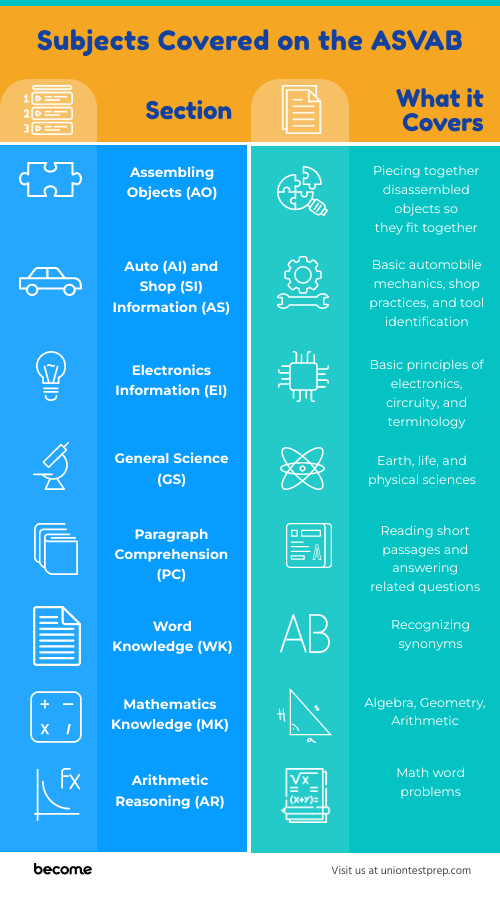
How is the ASVAB Scored?
Each branch requires a minimum Armed Forces Qualification Test (AFQT) score for joining the military. This is not a separate test, but a measure of how well you scored on four subsections:
-
Arithmetic Reasoning (AR)
-
Mathematics Knowledge (MK)
-
Paragraph Comprehension (PC)
-
Word Knowledge (WK)
Your score for these sections is then ranked against a reference group (representative examinee sample) as a percentile. For example, if you’re given an AFQT score of 77, that means you scored higher than 77% of the reference group. The percentile maxes out at 99%.
AFQT minimums change often, so it’s important to check official U.S. military sources to verify the most up-to-date information. The current ASVAB minimums are:
-
Navy: 35
-
Marine Corps: 31
-
Army: 31
-
Air Force: 36
-
Coast Guard: 36
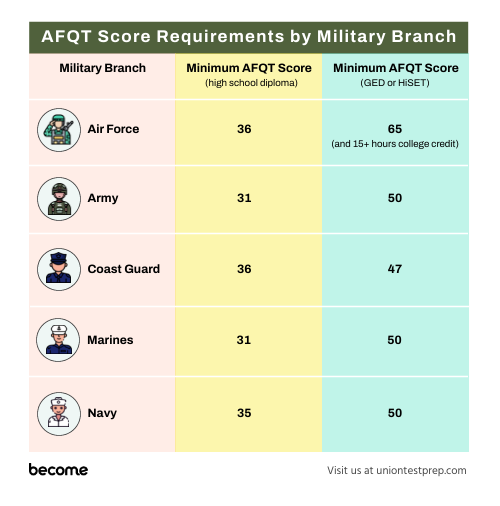
Your vocational aptitude scores also determine what military careers you can qualify for, although this is also subject to other factors.
ASVAB Scores and Career Choices
Your career choices for the Armed Services will be based on the composite scores of relevant ASVAB sections. These are also referred to as “line scores” and are based on individual branch requirements.
For example, to qualify for the Navy rating Electricians Mate (EM), you’d need one of the following composite scores:
-
VE+AR+MK+MC= 210
-
AR+MK+EI+GS= 210
The Army, however, breaks this down by a line score and an MOS requirement:
-
Line Score: Electronics= (GS)+(AR)+(MK)+(EI)
-
MOS 12P: Prime Power Production Specialist= GT:110 & EL:107 & ST:107
-
MOS 12Q: Transmission and Distribution Specialist= EL:93
-
MOS 12R: Interior Electrician= EL:93
This process can be confusing, and the requirements are subject to change. It’s always best to check with your recruiter or counselor to confirm the vocational aptitude scores needed for the career(s) of your choice.
Your ASVAB score is still just one factor for career choice. Even if you qualify for a certain U.S. military career based on vocational aptitude, there are other factors that determine whether or not you can enlist in that job:
-
Physical fitness
-
Clearance requirements
-
Enlistment quotas
-
Critically undermanned jobs
-
Overmanning or force reductions
Your best strategy is to study hard so you have the most career choices.
How to Study for the ASVAB
There are many tools available to help you perform well on the ASVAB. Union Test Prep offers a comprehensive study strategy:
-
Lessons
-
Practice tests
-
Flashcards
-
Study guides
There are also discussion forums and classrooms so you can learn and study with other people. If you want to (metaphorically) blow the test out of the water, you’ll need these resources.
You should also set aside a realistic study timetable. The ASVAB isn’t a test that’s easily crammable in a couple of nights just before the exam.
This is also a bad strategy to begin your U.S. military career, since it will consist of regular physical fitness and advancement tests. If you rely on last-minute cramming, you may see higher rank opportunities consistently pass you by.
Why Wait? Start Your Way Into Joining the Armed Services Today
In today’s uncertain economy, a military career offers all the training and resources you need for long-term success. Now that you know the answer to critical questions like, “How long is the ASVAB?” you can begin preparations to dominate the test and take your first steps into the Armed Services.
Check out our practice tests to get started, or take a look at our lesson plans. We give you all the resources you need right at your fingertips!
Keep Reading
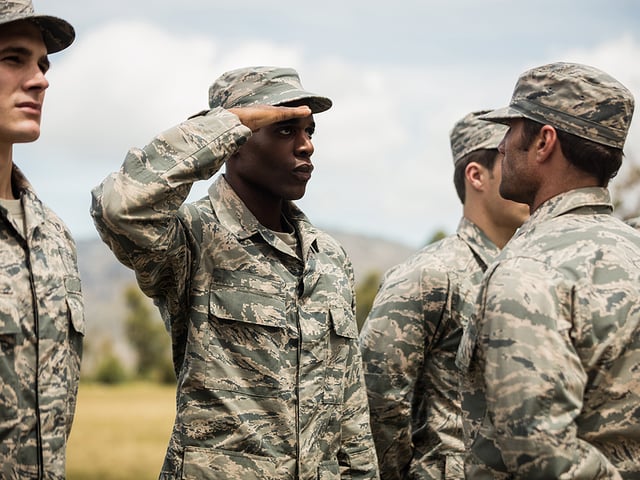
Armed Services Vocational Aptitude Battery Blog
What is the ASVAB Test?
The Armed Services Vocational Aptitude Battery, known as the ASVAB, is …
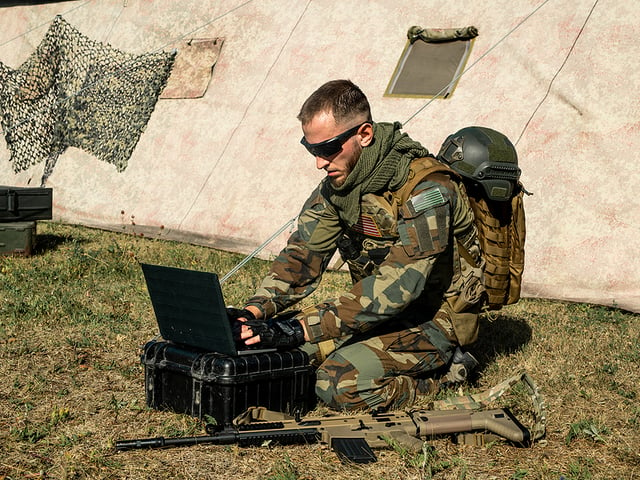
Armed Services Vocational Aptitude Battery Blog
Military MOS Codes
Military Occupational Specialty (MOS) codes are an integral part of the…
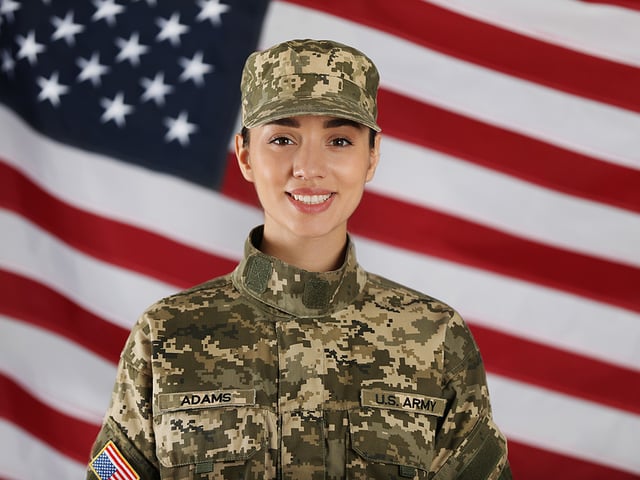
Armed Services Vocational Aptitude Battery Blog
U.S. Army Height and Weight Standards for Females
The U.S. Army’s commitment to maintaining a robust, physically fit, and…